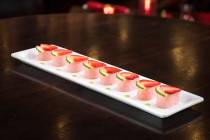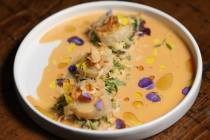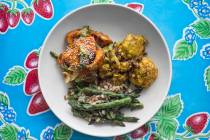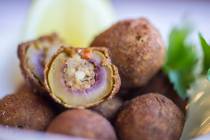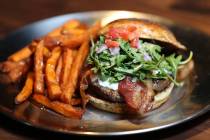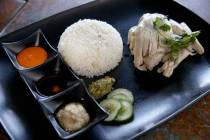Autumn is the perfect time to enjoy pears

If it’s fall — which it is — it’s pear season, with the autumn-hued beauties showing up in groceries and farmers markets, ready to be eaten out of hand or turned into breads, desserts, salads or entrees. At Gilcrease Orchard in the northwest part of the valley, they’re even being turned into cider.
Director Mark Ruben said the orchard grows three varieties of pears, which are mostly picked and ready at the orchard’s farmstand, where pear cider (as well as apple cider) also is available for $4 a half-gallon.
"Pear cider’s actually richer than apple cider," Ruben said. "One of our customers calls it ‘dessert in a glass.’ "
Ruben said by far the most popular of the orchard’s pears is one that "we’re not really sure what it’s called, but we’re calling it a Monterey. It’s the best pear we have."
The Monterey starts out green, turns yellow and then, as it ripens, turns slightly brown, appearing almost bruised.
"I like it even a little bit green," he said. "Green all the way to soft, it’s a good eating pear."
The California, he said, is a little woodier but has a bit of a cinnamon flavor. The third is the Comice, and all three are used in the cider.
"They get some russeting, so they’re really kind of an ugly pear," Ruben said of the Comice. "When the leaves rub on them, they get a lot of abnormalities on the skin. Usually when you grow a pear out here in the desert, they’re a bumpy pear; they’re not real smooth."
But in the northwestern United States, source of 84 percent of fresh pears grown in the country, that’s definitely not the case.
"We have ideal growing conditions — warm days, cool nights and volcanic soil," said Cristie Mather, director of communications for the Pear Bureau Northwest. "The soil is really perfect for pear-tree nourishment."
And Mather is clearly partial to the Comice.
"It’s a knee-bucklingly good pear," she said. "In tastings, people say, ‘Oh, my gosh, I’ve never tasted a pear like this. It has a custardy texture, nice and sweet — a round, succulent pear," and the type that catalog giant Harry & David brands Royal Riviera, Mather noted.
Megan Romano, executive pastry chef of Aureole at Mandalay Bay, likes to peel, slice and core Comice pears in warm honey, add some butter and serve with a frangipane tart with green-cardamom ice cream. But it’s far from the only pear in her culinary quiver.
"I like them all for different reasons," Romano said. "The Forelle pear is very nice; that’s a great-sized pear. The Bartlett is a nice-eating, juicy pear. The Bosc has less sugar content and stays crisper and firmer. It’s always a nice, fresh addition to garnish a dish, or in poaching, because it holds up well."
She serves the Forelle Chambord-and-Port-poached on a dark-chocolate Linzer tart.
"It’s the beginning of the richness of fall flavors," Romano said.
Or she’ll prepare a fondue plate with a teacake made with green-pear tea leaves, which smell like the skin of a pear.
"I warm up the butter and put the tea in there," she said. "A very small amount in a poundcake makes it just beautiful and takes on a season, a whole new flavor profile." She might serve it accompanied by pear sorbet, or in "all sorts of other applications."
Ruben said he expects to have pears through the end of October. At the orchard, they pick them when the seeds start turning brown (cutting into a test specimen to check), then put them in cold storage for a couple of weeks, which takes away a hint of bitterness, he said. Then they’ll ripen them at room temperature.
Mather explained that pears don’t ripen on the tree, but only after they’re picked.
In the market, she noted, if they’re firm, "they’re still in the process of ripening."
To check for ripeness, press the neck with your thumb; if it feels soft, the pear is ripe and ready to eat.
"Some change color as they ripen, like Bartlett, but most don’t," Mather said.
The harvest started in late August with Bartlett, Red Bartlett and Starkrimson; they’ll be in season until February, she said.
Right now, the harvest of Anjou is beginning. Anjou is "the most abundantly grown variety in the Pacific Northwest," Mather said.
During the peak season of November through March, there will be 10 types of pears in the market, she added.
One of the newest to see wide distribution is the Concorde, which has a long, thin neck and bell-shaped bottom.
"It’s a firm pear, so it’s really good for cooking," Mather said. "The unique thing is it has this really nice vanilla essence." It also is slower to oxidize, or turn brown after cutting.
Anjou and Bosc are firmer-fleshed and good for cooking, she said, and Bartlett, Starkrimson and Red Bartlett are juicier, which make them best when used fresh, as in salads, "because that’s really when the flavor shines."
Romano is clearly sold.
"Pears are nice, because the integrity of the texture holds up very well in baking and really complements a pear tarte tatin, a frangipane tart, pear clafouti," she said. "They still have that firmness when you eat them afterward, which is a nice aspect of the fruit."
BIBB LETTUCE SALAD WITH GORGONZOLA AND FRESH PEAR DRESSING
3 large ripe Bartlett pears (divided use)
1/3 cup granulated sugar
½ teaspoon fresh tarragon, or scant ¼ teaspoon dried
1 to 2 tablespoons cider vinegar
1½ tablespoons lemon juice
2 to 3 heads Bibb lettuce, rinsed and dried
4 ounces (1 cup) crumbled Gorgonzola or other blue cheese
Peel, core and chop one pear. Place chopped pear, 1/3 cup water, sugar and tarragon in a small saucepan. Simmer over medium heat until pear pieces are soft, about 5 minutes. Do not let all of the water evaporate; there should be about 7/8 cup pear and liquid. Cool.
Pour pear and liquid into a blender and blend until smooth. Add part of the vinegar and lemon juice to taste. Taste and adjust sugar and acid to make a sweet-tart dressing, adding a little water, if needed, to thin. Refrigerate until cold.
Core and thinly slice remaining pears. For each serving, arrange three to four lettuce leaves on each salad plate. Top with one-third of a sliced pear and 2 to 3 tablespoons Gorgonzola and drizzle with 2 tablespoons dressing. Serve immediately.
Serves 6.
BALSAMIC-FIG-GLAZED, PEAR-TOPPED CHICKEN BREAST
4 ounces goat cheese
¾ teaspoon dried thyme
¼ teaspoon fresh minced garlic
3 pears, cored and cut in half
1 1/3 cups low-sodium chicken broth
1½ cups dried figs
¾ cup balsamic vinegar
¼ cup sugar
6 boneless, skinless chicken breast halves
2 teaspoons salt
1 teaspoon ground black pepper
Cut figs for garnish (optional)
Thyme sprigs for garnish (optional)
Preheat oven to 375 degrees.
Mix cheese, thyme and garlic until blended. Place 1 rounded tablespoon of the cheese mixture into center of each pear half.
Puree chicken broth, figs, vinegar and sugar in batches in blender until smooth. Pour into strainer set over bowl. Press liquid into bowl and discard solids. Pour half of fig sauce into 13-by-9-by-2-inch pan.
Place chicken breasts over fig sauce in pan. Sprinkle with salt and pepper. Place a filled pear half cut side down over each chicken breast and drizzle with remaining fig sauce. Cover pan with foil and bake for 20 minutes. Remove foil and continue to bake, basting occasionally, 30 to 40 minutes, until chicken reaches an internal temperature of 160 degrees.
Cut each chicken breast and pear in half to serve. Spoon sauce over pear. Garnish with cut fig and thyme sprig, if desired.
Serves 6.
BOSC PEAR LASAGNA WITH ALMONDS AND BRIE
2 tablespoons ground anise (divided use)
1 pound brie cheese (divided use)
4 cups white sauce
2 pounds ricotta cheese
6 eggs
Salt and white pepper, to taste
4 Bosc pears, peeled, cored and cut in ½-inch pieces
12 uncooked lasagna sheets
2¼ ounces toasted sliced almonds
Preheat oven to 350 degrees.
Combine 1 tablespoon anise and ½ pound brie with white sauce.
Mix ricotta, eggs, remaining anise and remaining brie. Season to taste. Combine pears with ricotta mixture.
Ladle ½ cup of cream sauce into the bottom of a 9-by-11-inch baking pan. Layer the pan with four uncooked pasta sheets. Top with half of the ricotta mixture. Top with one-third of the almonds. Ladle 1 cup white sauce on top.
Create a second layer, alternating noodles, ricotta mixture, almonds and white sauce. Cover with final four sheets of pasta and remaining sauce, making sure all pasta sheets are covered with sauce. Cover with lid or aluminum foil and bake for 30 minutes.
Uncover; top with remaining almonds and bake for an additional 15 minutes. Let cool 5 minutes before cutting and serving.
Serves 8 to 10.
— Recipes adapted from the Pear Bureau Northwest
OVEN-BAKED PEAR PANCAKE
3/4 cup brown sugar (divided use)
1/3 cup flour
1/3 cup milk
4 eggs, separated
1 teaspoon baking powder
Dash of salt
3 tablespoons unsalted butter
1 teaspoon cinnamon
4 ripe pears, peeled, cored and sliced
1/4 cup chopped walnuts
Preheat oven to 375 degrees. Combine 1/4 cup brown sugar, flour, milk, egg yolks, baking powder and salt in a bowl. Mix well with a fork and set aside.
Combine butter, 1/4 cup brown sugar and cinnamon in an ovenproof skillet or frying pan. Cook on stovetop until butter melts and combines with sugar. Remove from heat. Arrange the pear slices in the butter mixture in the pan and sprinkle with walnuts.
Mix egg whites and remaining brown sugar in a small bowl until soft. Combine with egg-yolk mixture. Pour over pear slices and bake in oven for 10 minutes, until brown.
Serves 4 to 6 as a breakfast or dessert.
Contact reporter Heidi Knapp Rinella at hrinella@review journal.com or 702-383-0474.









